Benfica are one of the biggest clubs in Portugal, and there is absolutely no doubt about that, but when the club was looking for a coach in the summer of 2022, the team was going through a rough patch, losing out to FC Porto and rival Sporting for multiple years in a row.
Roger Schmidt took over Benfica at the beginning of the 2022/23 season as the new head coach, replacing Nelson Verissimo after a disappointing season finishing third in the league with a gap of 17 points from top.
While it didn’t look like a match made in heaven to most experts, Roger Schmidt and his team made the most out of their first season, being one of the best teams in Europe, becoming league champion for the first time in four years, winning the first championship since Bruno Lage left and reaching the quarter-final of the UEFA Champions League, a great feat for the Portuguese club.
Only losing five out of 55 games during the 2022/23 season, Benfica were set for greatness in the upcoming years.
The 2023/24 season proved to be a bit more problematic, however.
While Roger Schmidt and his men played a decent season again, arch-rival Sporting finished top of the league with 10 points more than Benfica had.
In the Champions League, Benfica did not manage to get past the group stages and dropped down to the Europa League consequently, but even there, they disappointed and got eliminated by a struggling Olympique Marseille side.
Roger Schmidt was backed by the entire Benfica board over the course of the season, but after a rather mediocre start to the 2024/25 season, Benfica pulled the trigger on the first coaching change in Liga Portugal this season and replaced Roger Schmidt with former coach Bruno Lage.
In this team analysis, scout report and tactical analysis, we will take a look at what problems Benfica has been facing over the first four games of the season, where the team needs to improve and what options Bruno Lage has after taking back over at the helm of his old club.
Roger Schmidt Formations & Players Used
If we are talking formations and Roger Schmidt, there is not much to talk about to be honest.
During his entire career, Schmidt has utilised a hybrid 4-4-2/4-2-3-1-formation, a 4-4-1-1 if you will.
During his Benfica tenure, he has exclusively used this formation and that obviously means he has done so in the first four games of this season as well.
If we are looking at the personnel side of things, Schmidt has been facing the same adversity every Benfica coach has faced over the years.
Benfica might be a club that is able to develop and even buy elite talent for the team, but the club is not able to keep those players after a good season, they are dependent on selling.
Schmidt has had to cope with a lot of sales during his tenure: Just before he became head coach, the club sold superstar-striker Darwin Núñez, Enzo Fernández left Benfica after just half a season there, Alejandro Grimaldo left the club on a free transfer and academy product Gonçalo Ramos went on to PSG last summer.
Most of the time, the club is able to work through these types of sales with their great academy as well as a very good recruiting strategy, but they were hit hard this summer once again, we will take a look at that in just a bit.
For this season, this meant that the usual starting eleven featured Anatoliy Trubin in goal, a back-for consisting of Jan-Niklas Beste at left-back, António Silva and Tomás Araújo as the two centre-halves, Alexander Bah at right-back, a double-pivot with Florentino and Leandro Barreiro, Gianluca Prestianni as the number 10 right behind Vangelis Pavlidis up front with Fredrik Aursnes and João Mário flanking them as the wingers.
There have been multiple changes during the first four weeks of football for Benfica.
Jan-Niklas Beste got injured and Alvaro Carreras was pushed into the first eleven at left-back.
Experienced Nicolas Otamendi got put in at centre-back for a struggling Araújo in the latest game against Moreirense.
Just like Beste, Aursnes got injured and was replaced by Ángel Di María in the latest game.
And finally, captain João Mário left the club and was replaced in the starting eleven by Orkun Kökcü for the last two games of Schmidt’s reign at the club.
Benfica Coping With Sales & Recruiting
As stated previously, Benfica are not a club that keeps their key players for extended periods of time but rather prefers to sell them at the peak of their market.
Roger Schmidt obviously knew about that when he signed with the club and had experience with similar situations when he worked for Red Bull Salzburg or Bayer Leverkusen previously.
After his great debut season, the club was not hit with a huge wave of sales, which was rather surprising.
Still, they lost their top-striker Gonçalo Ramos to PSG in the summer of 2023 for a fee of €65m and this sale still has some consequences on the mediocre start to their season this year.
In terms of recruitment, Benfica takes the same approach they have taken for years: Recruiting young players from all over the world and promoting their elite academy talent into the first team.
This leads to talented teams, but if we are looking at the players that Benfica brought in during Schmidt’s term, they have not recruited a lot of established players to boast the team instantly, but they have invested heavily in the future by buying a lot of under-23-players, forcing Schmidt to develop these players.
Ramos was an elite striker for Benfica and the club knew they had to replace his production, so they invested heavily in striker Arthur Cabral last summer.
Unfortunately for them, the transfer did not work out as they intended.
This meant Benfica had to replace the offensive production of Ramos in a collective way.
Players that were already at the club, like striker Rafa, captain João Mário or winger David Neres took a leap last season and stepped up big time for Roger Schmidt.
Especially Rafa stepped up in an important way for Benfica as he went on to score 22 goals and provided 15 assists over the course of last season.
Unfortunately for the club, Rafa left on a free transfer to Benfica, where he was later joined by João Mário.
David Neres was sold to Naples this summer as well, leaving Benfica with a gaping hole in their offensive production.
On the defensive side of the squad, Benfica also lost Morato, who was a regular player at left-back and centre-back for Roger Schmidt last season.
This meant that Benfica had a lot of work to do over the course of the summer transfer window.
Surprisingly, the team has decided to take another route this summer, but before we need to talk about what players Benfica brought in, we have to talk about the players that Benfica lost over these last two months.
While the newly recruited players are also 25 or younger for the most part, with only Renato Sanches being an exception at age 26, Benfica has invested their money in more established players with multiple years of experience in European football.
Also, their focus shifted from South America and southern Europe to players from more established leagues, like the German Bundesliga, the English Premier League or the Turkish Süper League.
One of the priorities of the club was to reinforce their attack, because after losing Ramos, Rafa, João Mário and David Neres in the span of 12 months, they have had major problems with that part of their squad.
To achieve this goal, Benfica made a couple of transfers this summer, including Zeki Amdouni (loan with option to buy from Burnley), triggering the buy option for Benjamin Rollheiser and signing Kerem Atürkoglu from Galatasaray.
Vangelis Pavlidis Radar Map
The most important signing for their attack is their new striker, Vangelis Pavlidis.
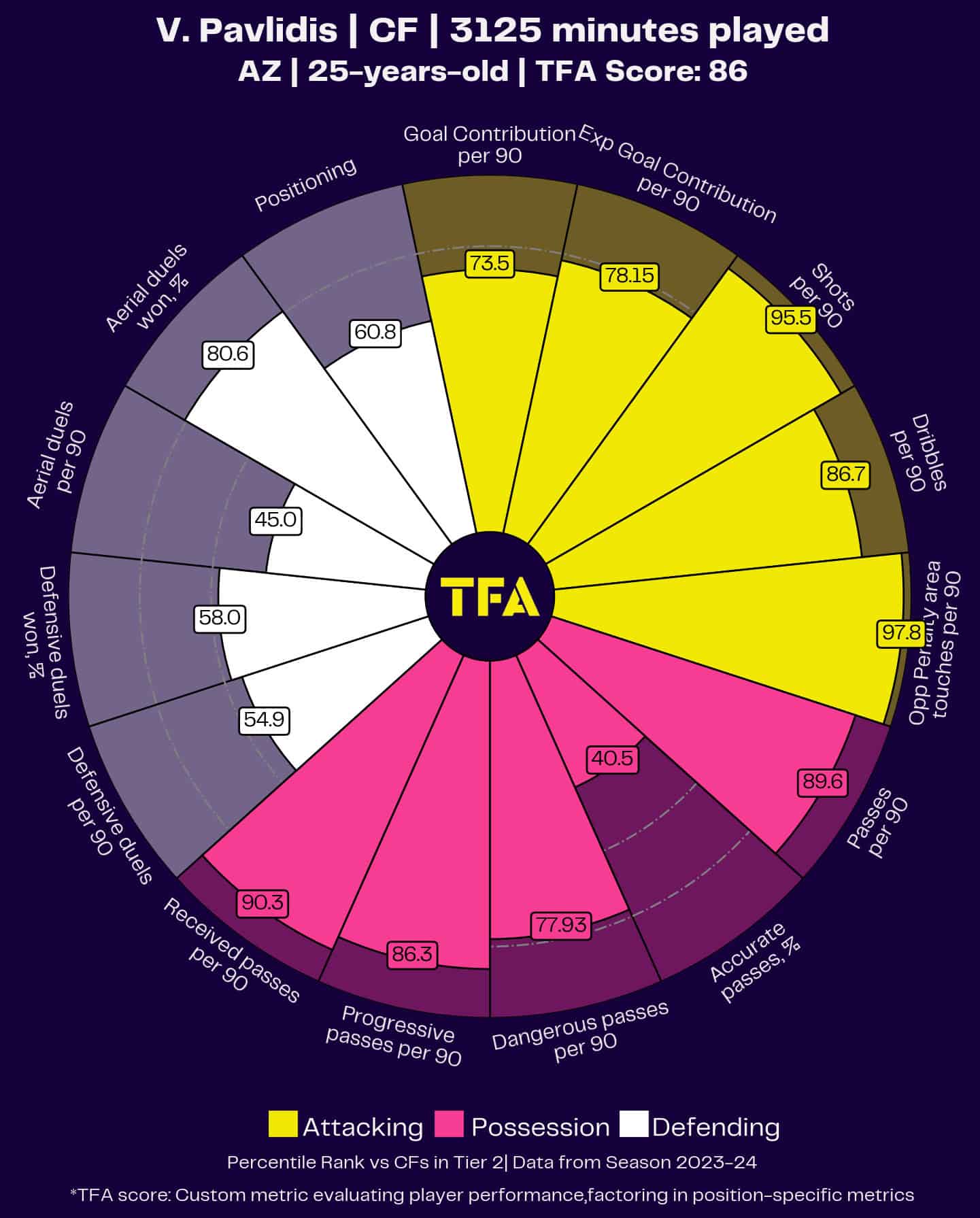
Pavlidis was signed from AZ Alkmaar in the Dutch Eredivisie for €18m, a very large sum for Benfica.
The 25-year-old Greek striker is supposed to fill the void that was left up front for Benfica ever since Núñez and Ramos left the club, respectively.
Pavlidis played in all 34 games in the Eredivisie last season, scoring a stout 29 goals and providing four assists for Alkmaar, scoring three more goals in six appearances in the Europa Conference League.
Pavlidis is supposed to be an immediate upgrade in the box for Benfica, providing finishing qualities and scoring goals from the get-go.
Pavlidis is way more than that, ranking in the 90th percentile in terms of passes played and in the 87th percentile for progressive passes, showing that he is more than capable to adapting to a more possession-based style of play.
Another neat thing about Pavlidis is his aerial ability, ranking in the 81st percentile in won aerials duels.
Having an actual target man upfront provides Benfica with an element to their game that they have not had in their squad last season.
Another priority was the left-back position after Morato left the club.
Morato always was not a perfect fit for Roger Schmidt’s fast pace Red Bull-like playstyle, so this summer was the chance to find a more tactical fitting player to fill the void.
After triggering the buy option clause in Carreras contract, Benfica went on to sign Jan-Niklas Beste from the biggest surprise in the Bundesliga last season, 1. FC Heidenheim.
Beste was a left-back while being at the youth level at Borussia Dortmund and Werder Bremen, but was moved to the left-winger position at Regensburg and then Heidenheim, where he had the season of his life in 23/24.
Beste is the late successor for Alex Grimaldo, who left for Bayer Leverkusen last season, having elite crossing and set-piece ability with his left foot, but Beste also has the same defensive struggles that Grimaldo has.
The entirety of the transfer window looked a bit odd from a Benfica standpoint, but in the end, the squad should have been better off in attack and in defence.
But if we are talking about this transfer window, we also have to talk about the midfield.
Mission Impossible: Replacing João Neves
If we are looking back at the past 1,5 years for Benfica and Roger Schmidt, there has been a lot of talk about how their teamwork is their biggest strength, but there still was one key player for them: João Neves.
Neves was part of the double-pivot with Florentino in this timeframe and even though he might be only turning 20 years old and the end of September, he is an unbelievable player.
João Neves Radar Map
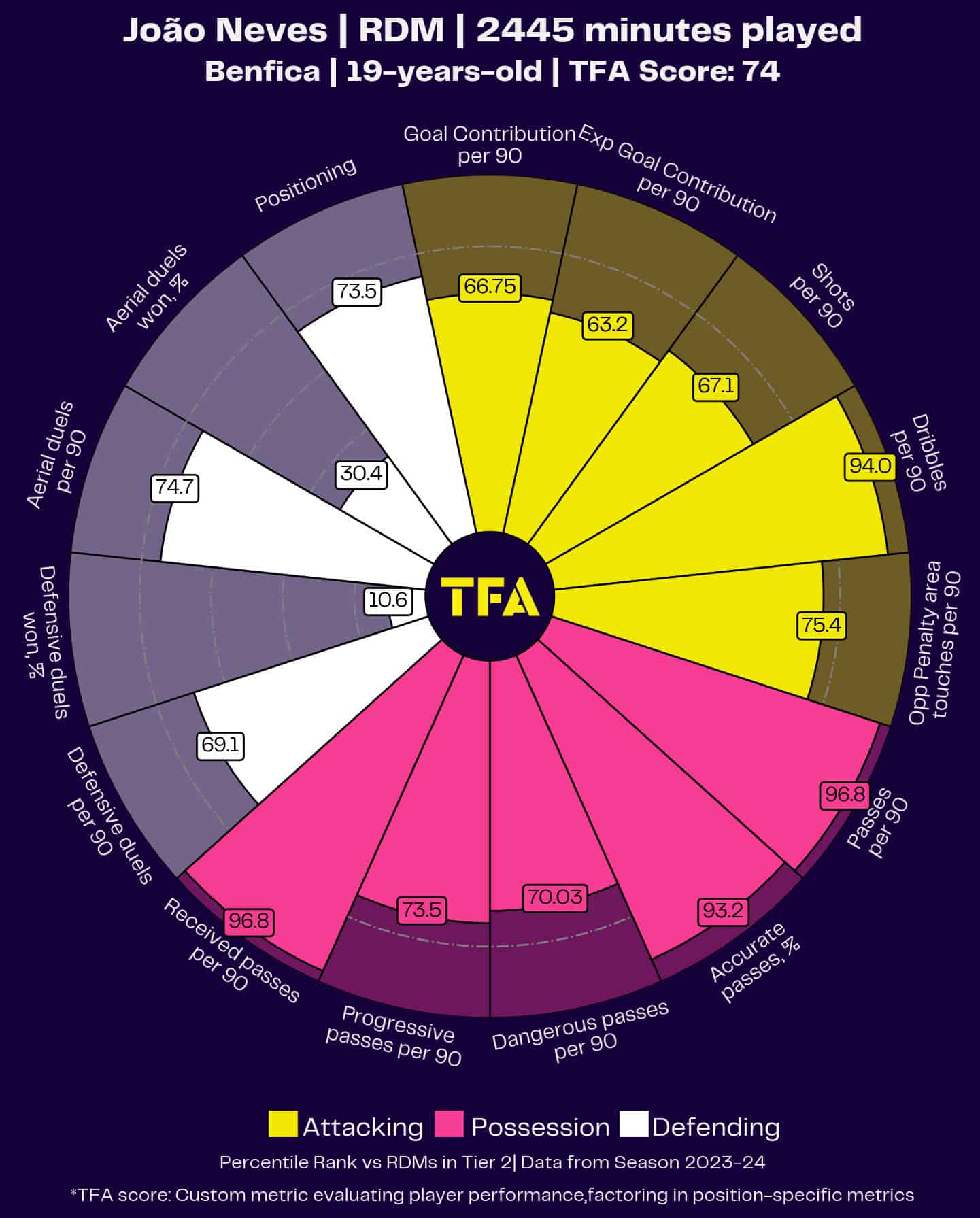
João Neves was the connective piece for Benfica, transitioning play from build-up into the attacking play.
With his elite passing ability as well as his great dribbling, Neves was always able to progress the ball for Roger Schmidt and his teammates.
Ranking in the 97th percentile of received passes per 90 and passes played per 90, it instantly becomes very clear that Neves had an essential role in Benficas play last season.
Neves always was open, able to receive the ball, turn around and pass it to another player or even just carrying the ball forward.
His ball security was absolutely elite, barely losing balls in tight spaces and with his 94th percentile in terms of dribbles per 90, he was also able to just get out of trouble with quick movements rather easily.
Unfortunately for Benfica, his talents were recognised by many European giants and in the end, Neves decided to leave the club towards Paris, where he had an elite start to this season for PSG as well.
There simply was no way for Benfica to replace the quality that João Neves was able to provide for them last season with no other academy prospect coming through the ranks at this position.
In the end, Benfica decided to sign Leandro Barreiro from 1. FSV Mainz 05 on a free transfer out of the Bundesliga.
The Louxemburgian international should be a great fit for Roger Schmidt’s heavy Gegenpressing playstyle and was instantly able to claim the starting spot next to Florentino to start the season.
Leandro Barreiro Radar Map
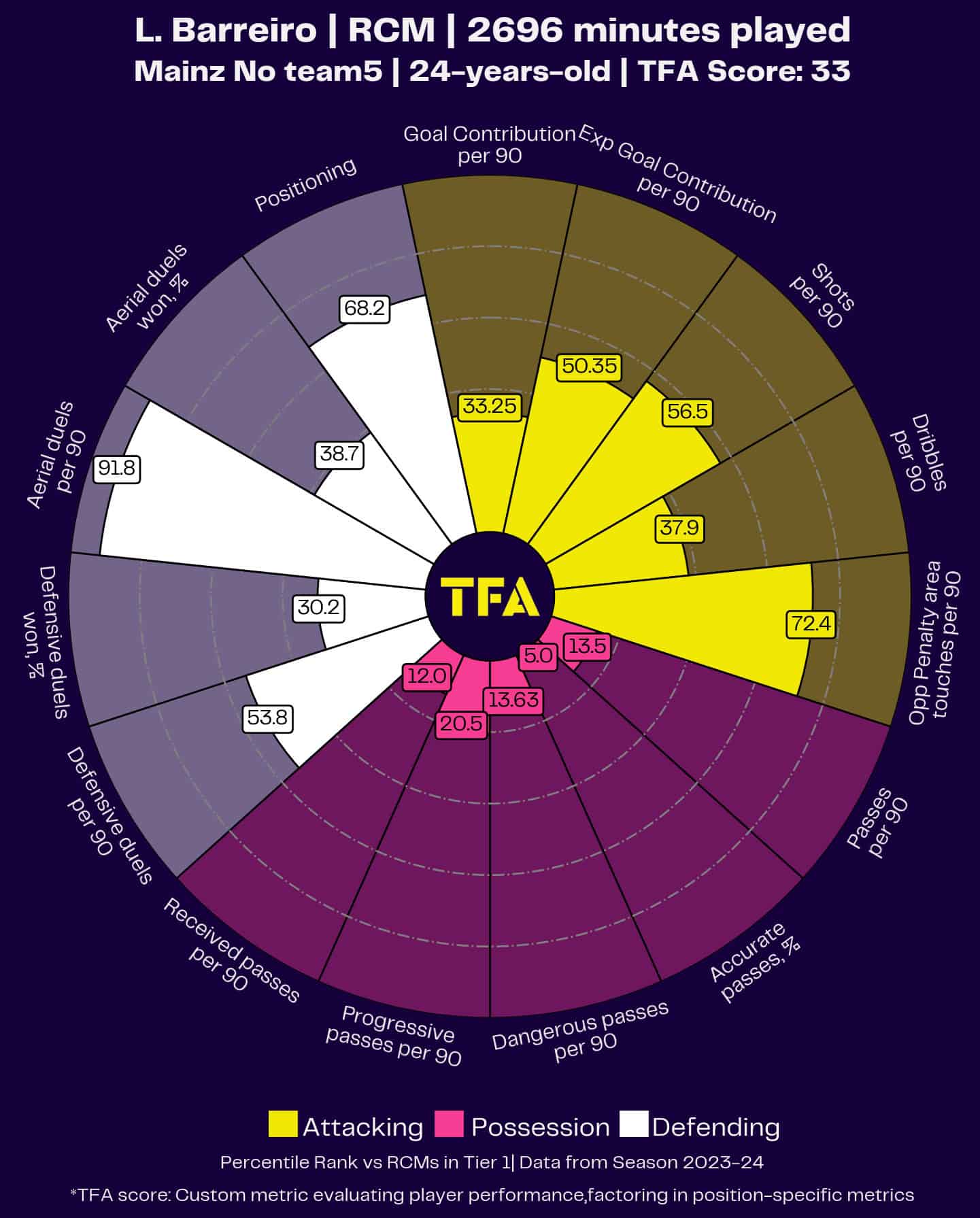
Unfortunately, Barreiro lacks the passing and playmaking ability that João Neves provided.
While he definitely is an upgrade in terms of pace, intensity and aerial ability, ranking in the 92nd percentile of aerial duels per 90, Barreiro does not rank higher than the 21st percentile in any possession stat.
This just shows that he struggles immensely with the ball and Bundesliga watchers know, that Barreiros biggest strength is his box-to-box-ability, while his build-up play and his passing overall just lack finesse.
This was a major setback for Benfica this summer and they still struggle to find some passing consistency in midfield.
Benfica Struggling In Possession: Build-Up
Roger Schmidt was never a coach who valued possession or a very controlled build-up play.
He always preferred to let his teams play with a very vertical approach, that is also one of the reasons he was hired by Red Bull Salzburg back in the day.
The centrepiece of Schmidt’s tactics is counterpressing and fast, vertical attacks after the resulting recoveries, but with Benfica being an absolute dominant top-team, he needed to find ways to adapt his playstyle to a more possession based style.
This season, Benfica has had some major struggles in playing out the ball from the back.
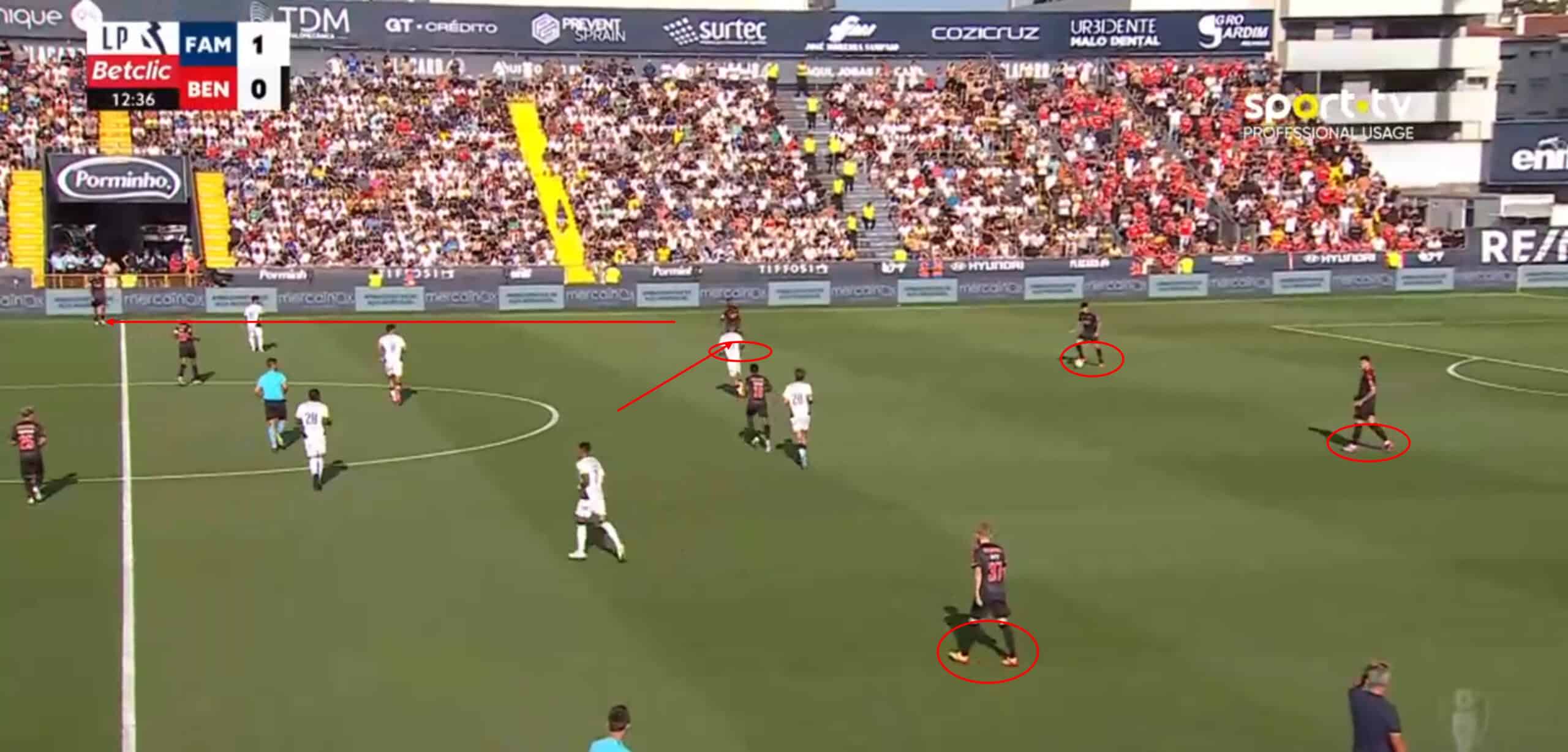
Here we can see a situation out of the game against FC Famalicao on matchday 1 this season.
Famalicao is dropping back and preparing their press out of a 4-4-2 formation.
To avoid the strong press that FC Famalicao usually play to get pressure onto the ball, right-back Bah is moving forward and Barreiro is falling back diametrical to create a four-man build-up again, providing some width so the Famalicao strikers can not instantly pressure the centre-backs.
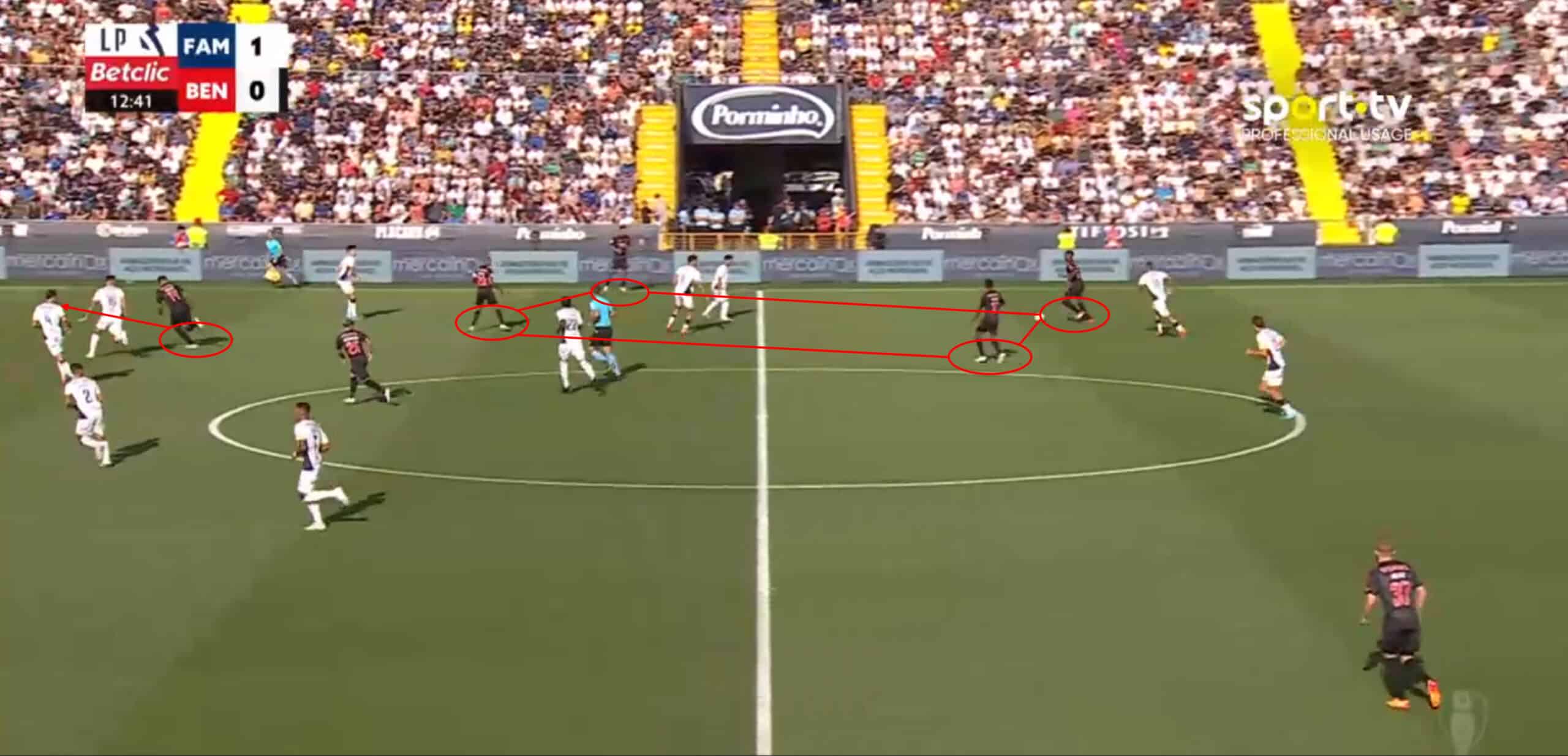
From there on, Barreiro can carry the ball forward and Schmidt’s men are trying to create a diamond formation on the right side of the pitch to overload that side and drag the right back out of position for a deep run by Pavlidis
As seen in the picture, Benfica fails to actually create a diamond in this situation, because Florentino is not pushing up the field enough, therefore the team is neither creating good passing options nor a numbers advantage in this area.
Barreiro lacks the passing ability to thread a ball in between the lines of Famalicao, which means he can only play the long ball towards Pavlidis deep run.
Pavlidis provides the run, but he is moving towards the corner of the pitch and not able to actually move towards goal, which results in a loss for Pavlidis high up the field.
Benfica was only able to play two passes and then lose the ball, which is not great, especially not for a top-team trailing.
Roger Schmidt also realised that this form of build-up play is not working with his current squad that lacks a midfielder with elite passing, so he adapted.
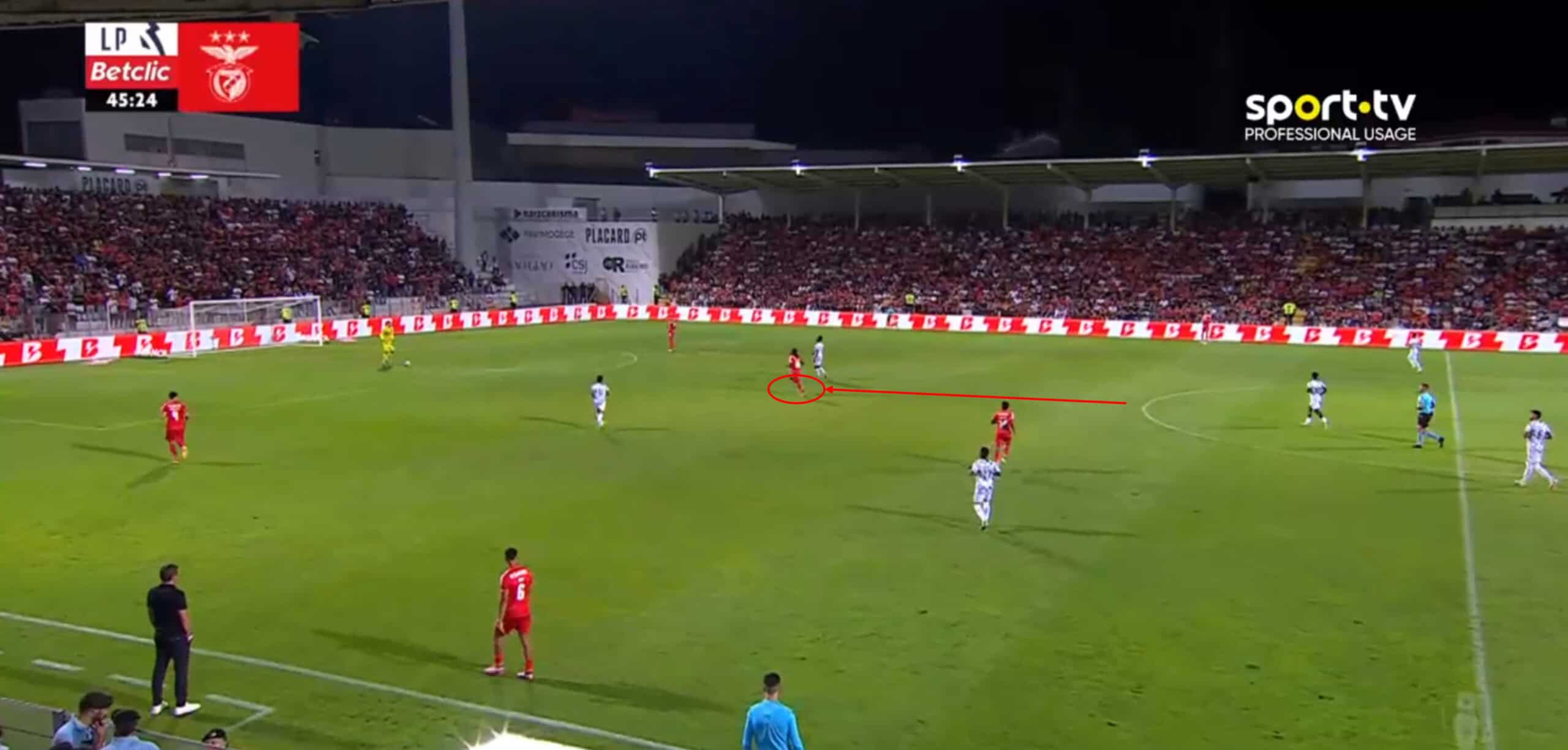
In his last game against Moreirense, Schmidt did not use a four-man build-up but rather had his full-backs push up high and had one centre mid, most of the time it was Renato Sanches, drop in between his centre-backs to create a back-three.
This meant that they always had the numbers advantage in their first line compared to the two strikers Moreirense was fielding while also still attracting the press.
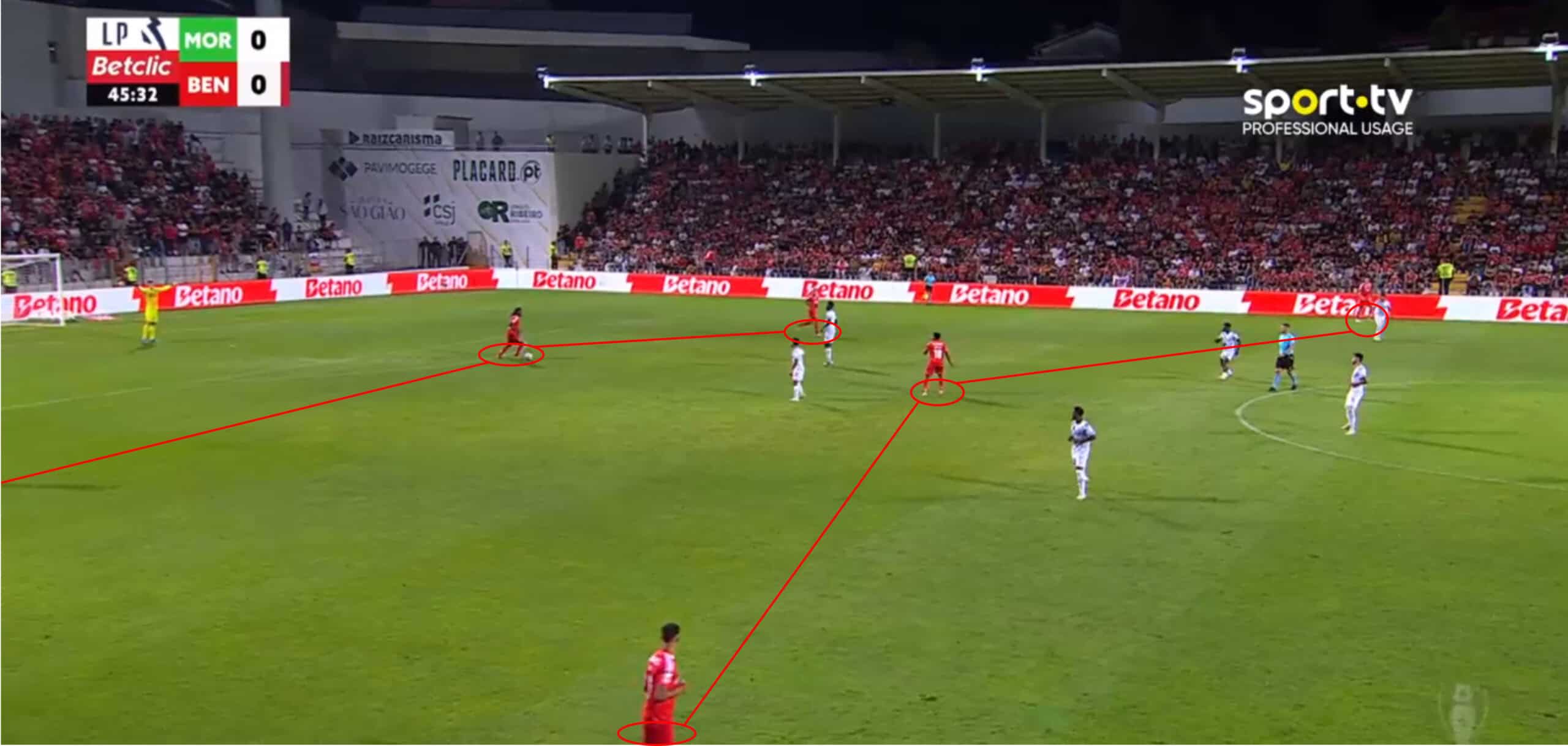
This created a very unusual 3-3-4 shape, which unfortunately is unusual for a reason.
Benfica was only able to pass it around in their back-three or play it to one of their full-backs, but they did not have any further passing options from there on.
While it may seem like Florentino is in a lot of space in the centre, he could easily be pressed by one of the Moreirense midfielders in a mere second, which meant that Benfica just gave up control over the midfield for no apparent reason.
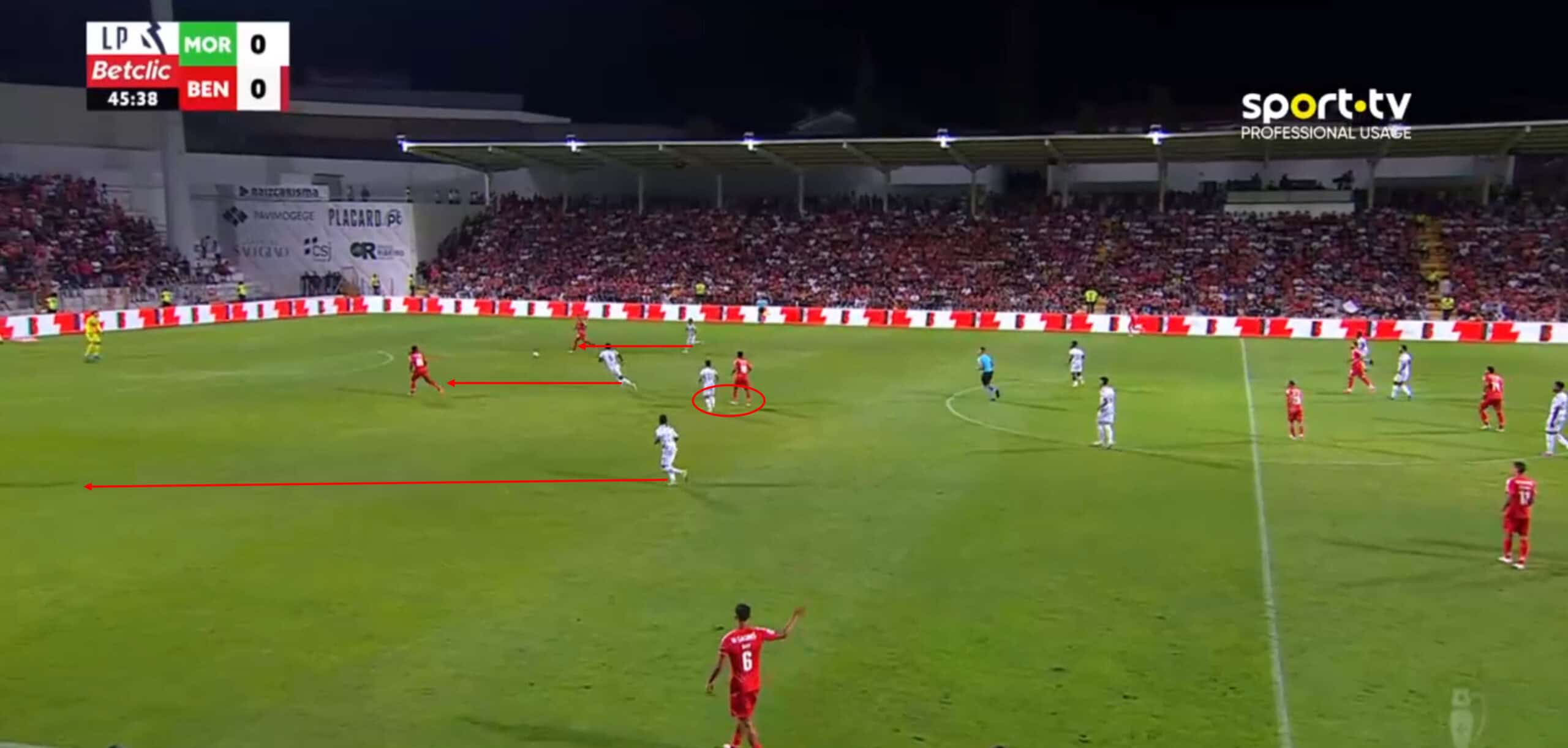
So with no real passing options to progress the ball, Renato Sanches plays a pass to his LCB, but because of the press, he is only able to receive the ball with his face towards the goal, which only triggered the press by Moreirense and forces Benfica into a tough spot.
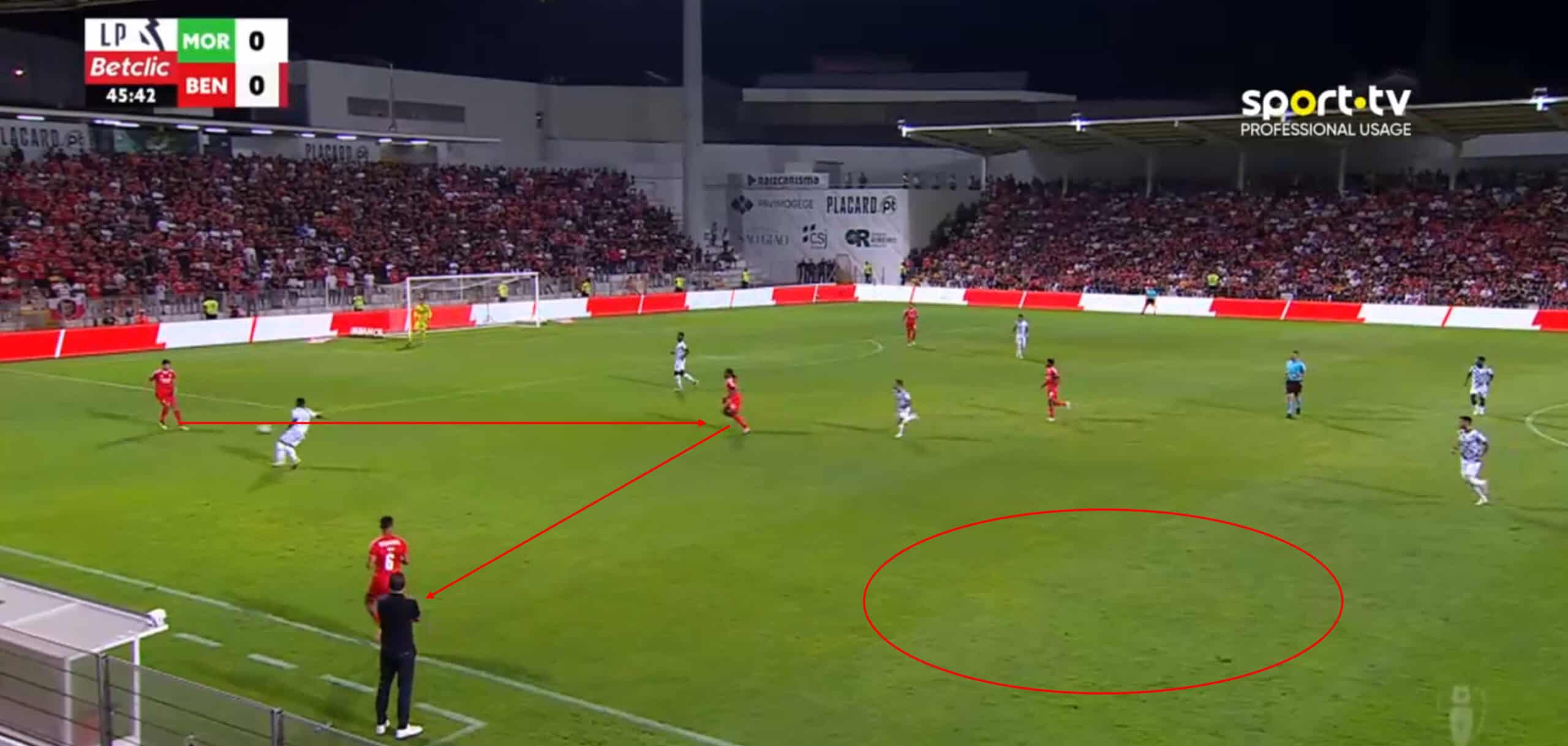
Moreirense is not a good team however and their press would have failed miserably here, as seen in the picture above.
Bah is wide open and Benfica is able to shred through the first pressing line by playing a simple third-man principle and in theory, Bah now has the possibility to progress the ball by carrying it into the open space in front of him.
But once again, the fine-tuning is just not there for Benfica and Bah’s body position is really bad, he doesn’t receive the ball in a at least half-open stance, he receives it while coming back with his face towards goal, which delays his carry and Benfica once again only is able to play a long ball that leads to nothing.
I honestly do not understand why Benfica just gives up control over the centre in every variant of build-up they are trying to play and that is something that Bruno Lage will need to fix quickly.
Benfica Struggling In Possession: Creating Chances
While Benfica creates the second most shot attempts per 90 minutes in Liga Portugal this season so far, they have only created the ninth most expected goals through four games this season so far, resulting in only 0.09 xG/shot, ranking only 13th in the league.
While Benfica do not struggle to create shots, the majority of their chances are half-chances at best and we will try to examine why that is in this paragraph.
On one hand, if we are comparing the Benfica players to the rest of the teams in the league, Benfica still have a suffocating advantage in individual class in every game against teams outside of the top-three teams.
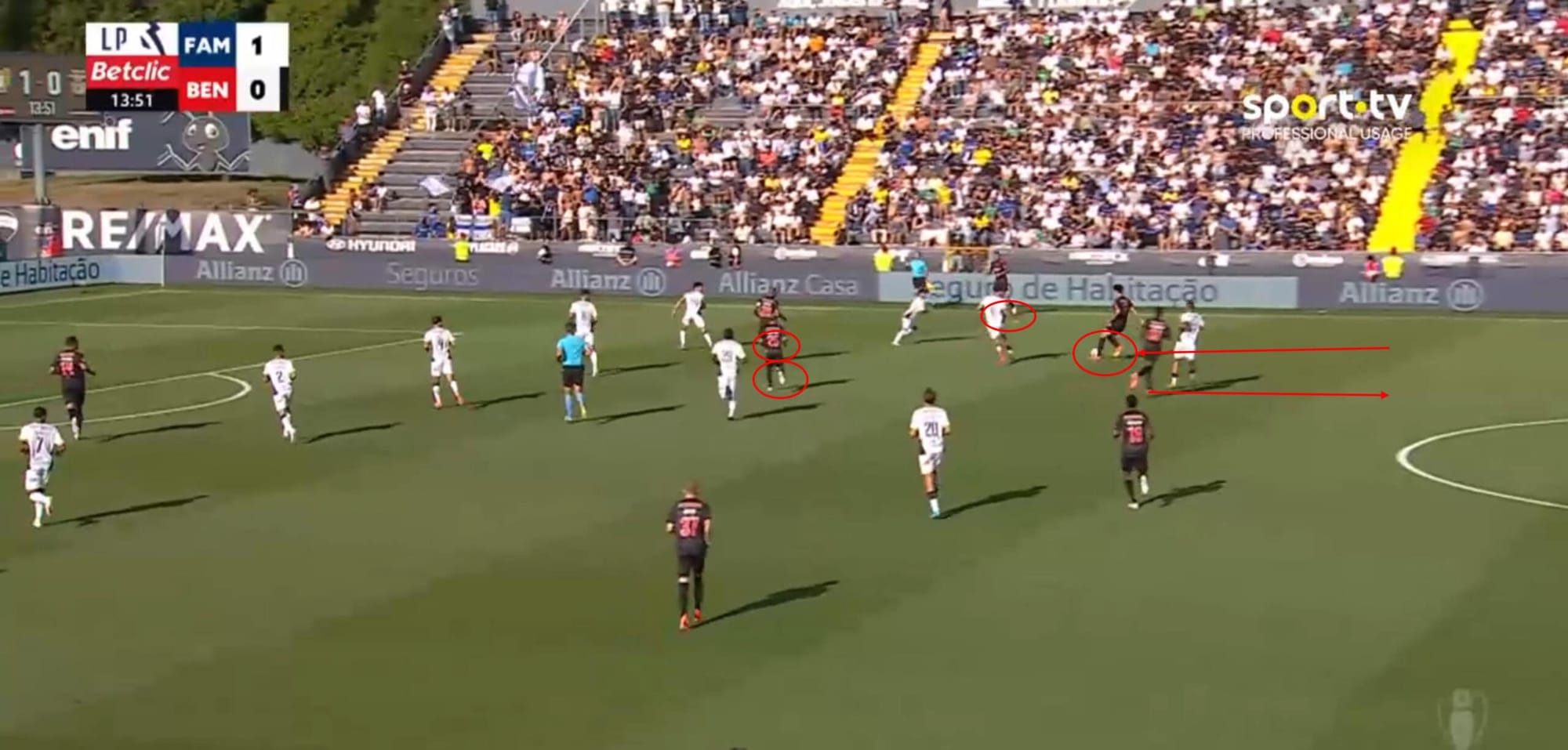
Like in build-up, Benfica really like to utilise the diamond formation on the wing in their attacking play.
Here centre-back Araujo moves forward and Florentino moves backwards to cover the space in behind his centre-back.
Unfortunately, Benfica does not create any passing options for Araujo once again, who can only play the ball outside towards Bah near the sideline.
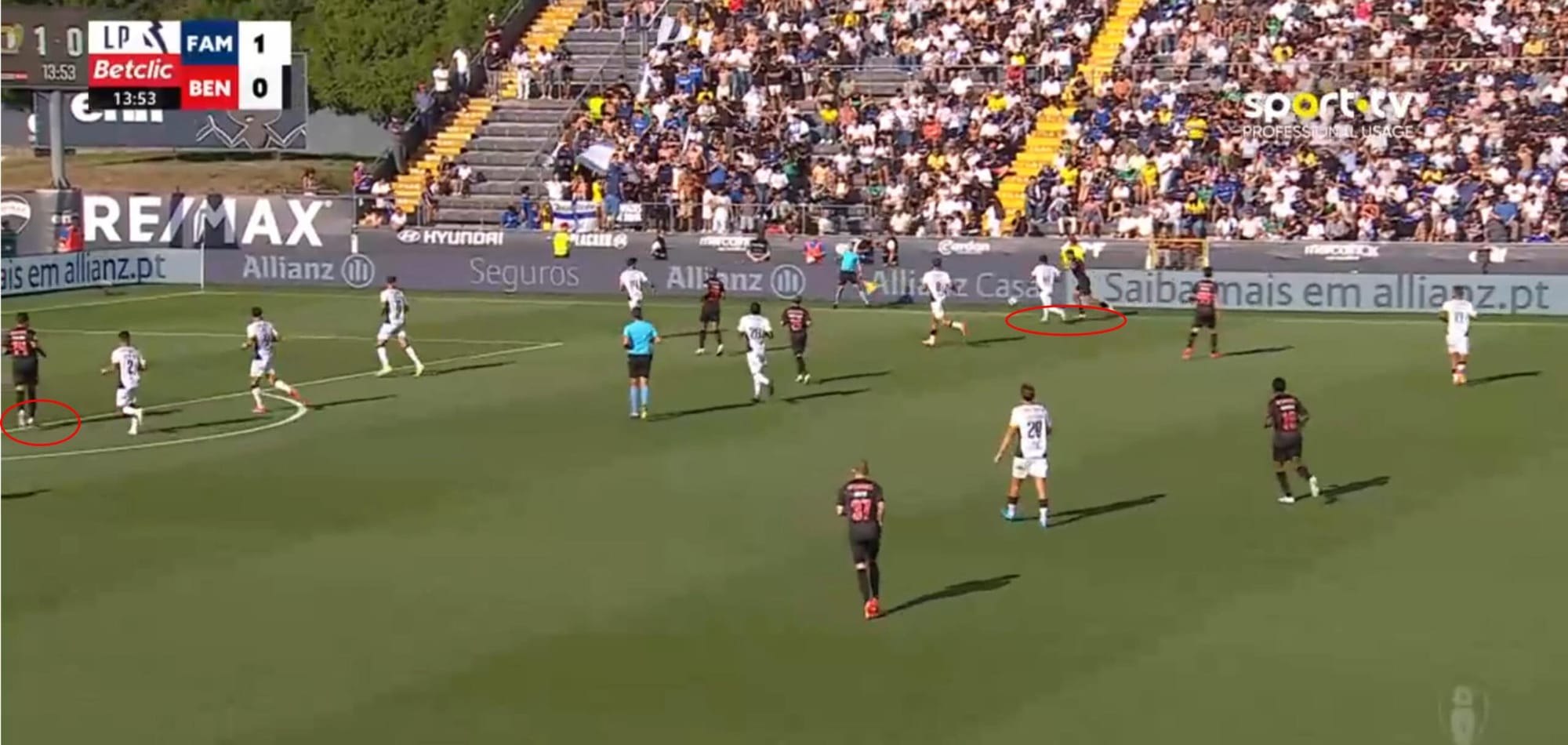
Bah is under pressure instantly and has to take a tough take-on with no other options.
If we are looking into the box, only Pavlidis is the only player making a run, so Bah does neither have a passing option nor the option to cross after his dribbling.
In this case, he can’t even get the cross past the defender.
This just shows why Benfica is bad at creating good chances, they do not get into the most important areas in the centre of the pitch and they do not create good crossing opportunities as well.
If you want to have successful wing play, you need to give your wingers options in the box and even at this simple task, Benfica fails rather miserably.
Also, when teams use diamonds to play the ball onto the wing, they do it to give the players quick and easy options for passes by making the orientation easier for the players.
Roger Schmidt’s men look completely lost with the ball on their feet, however.
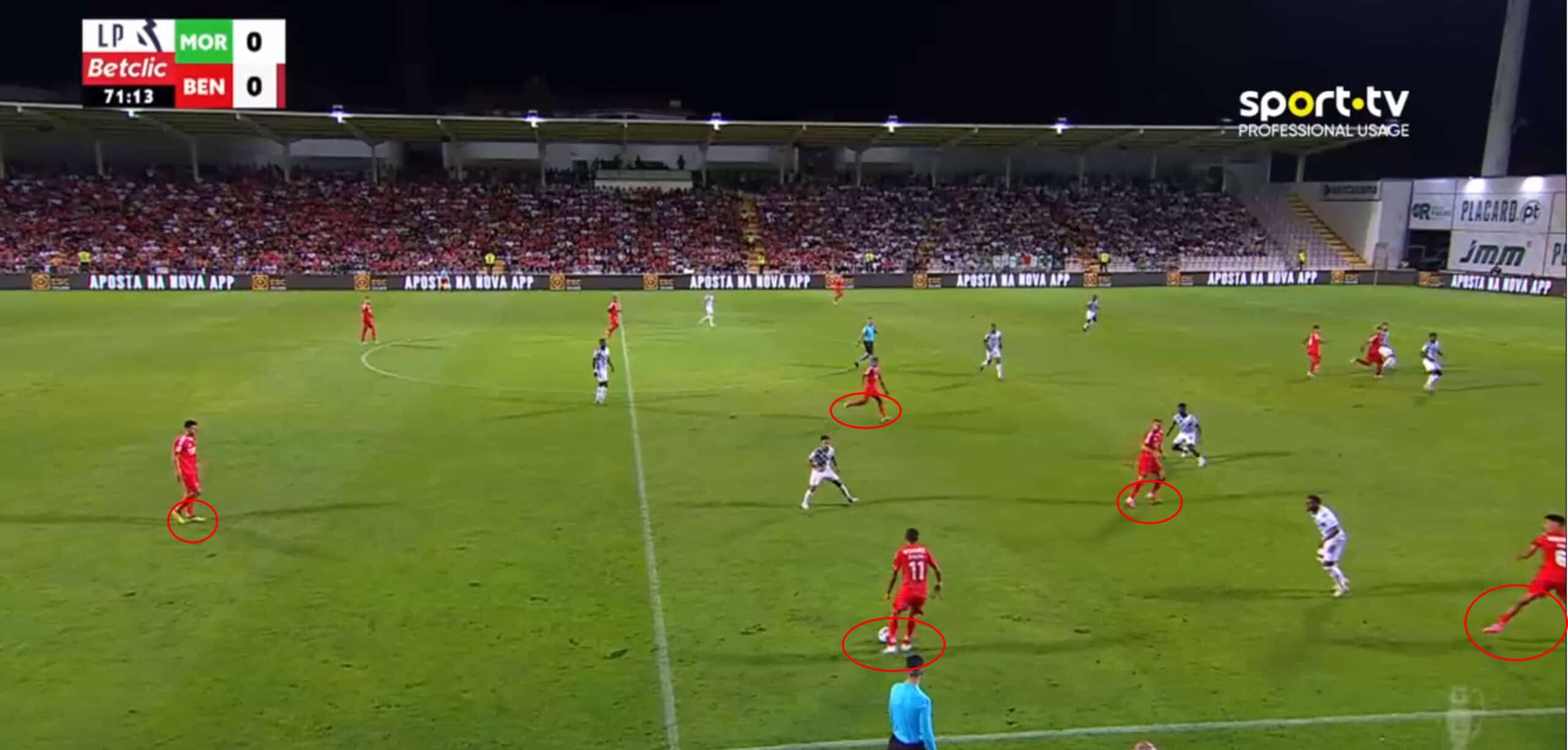
Here we can see them starting an attack with the diamond on the wing once again, even having Florentino as an additional option in the middle.
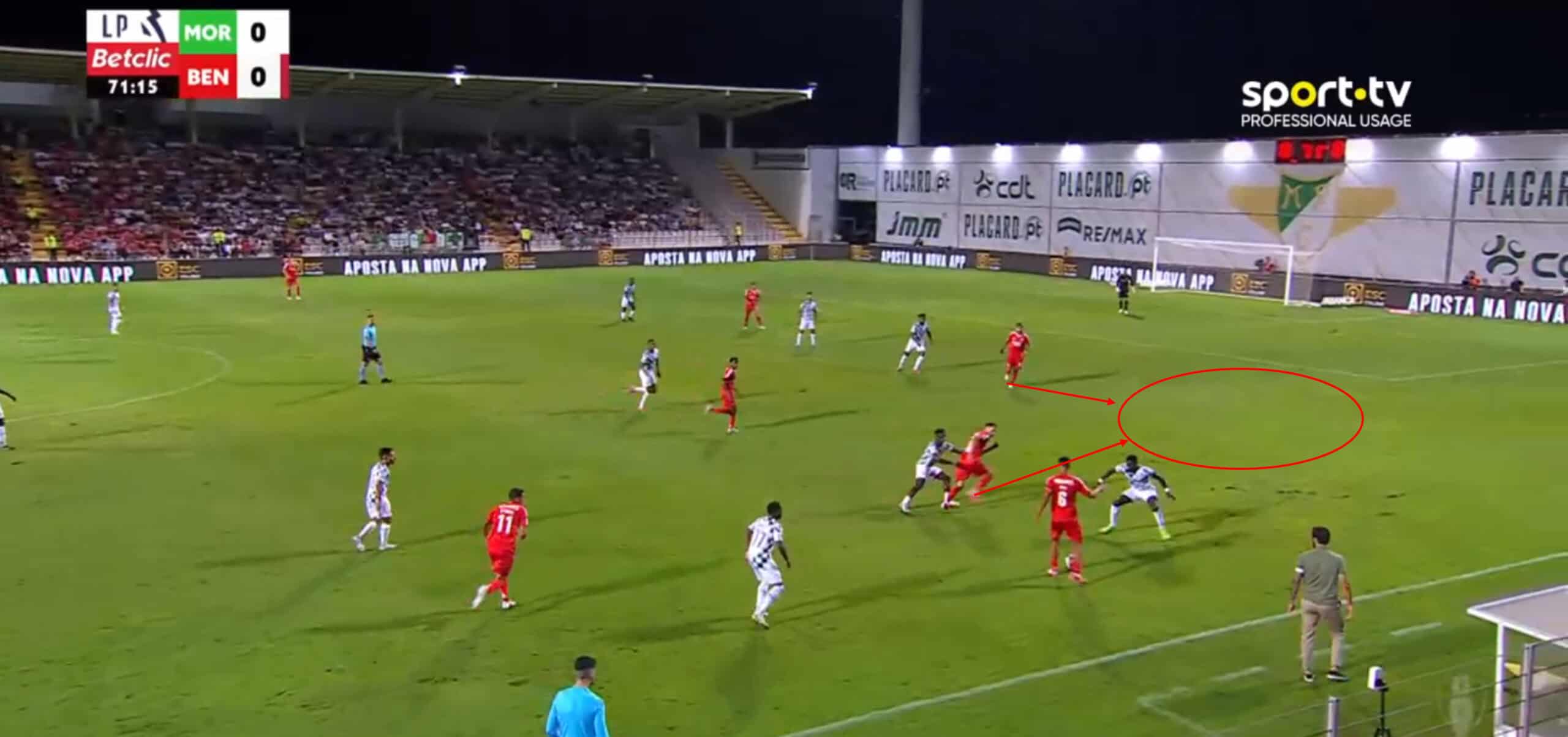
Former Real Madrid standout Ángel Di María plays the simple pass towards Bah, who even is able to control the ball and turn towards the goal without real pressure, but drags the right back out of position.
Kökcü instantly moves in behind the right back, trying to exploit the space Benfica created instantly.
The other players around Di María and Kökcü are having trouble with making the right reads and decisions in this situation.
Pavlidis, who should be in the box waiting to receive the ball from the wing, is moving out towards the wing as well, which once again leaves the centre of the pitch completely vacant.
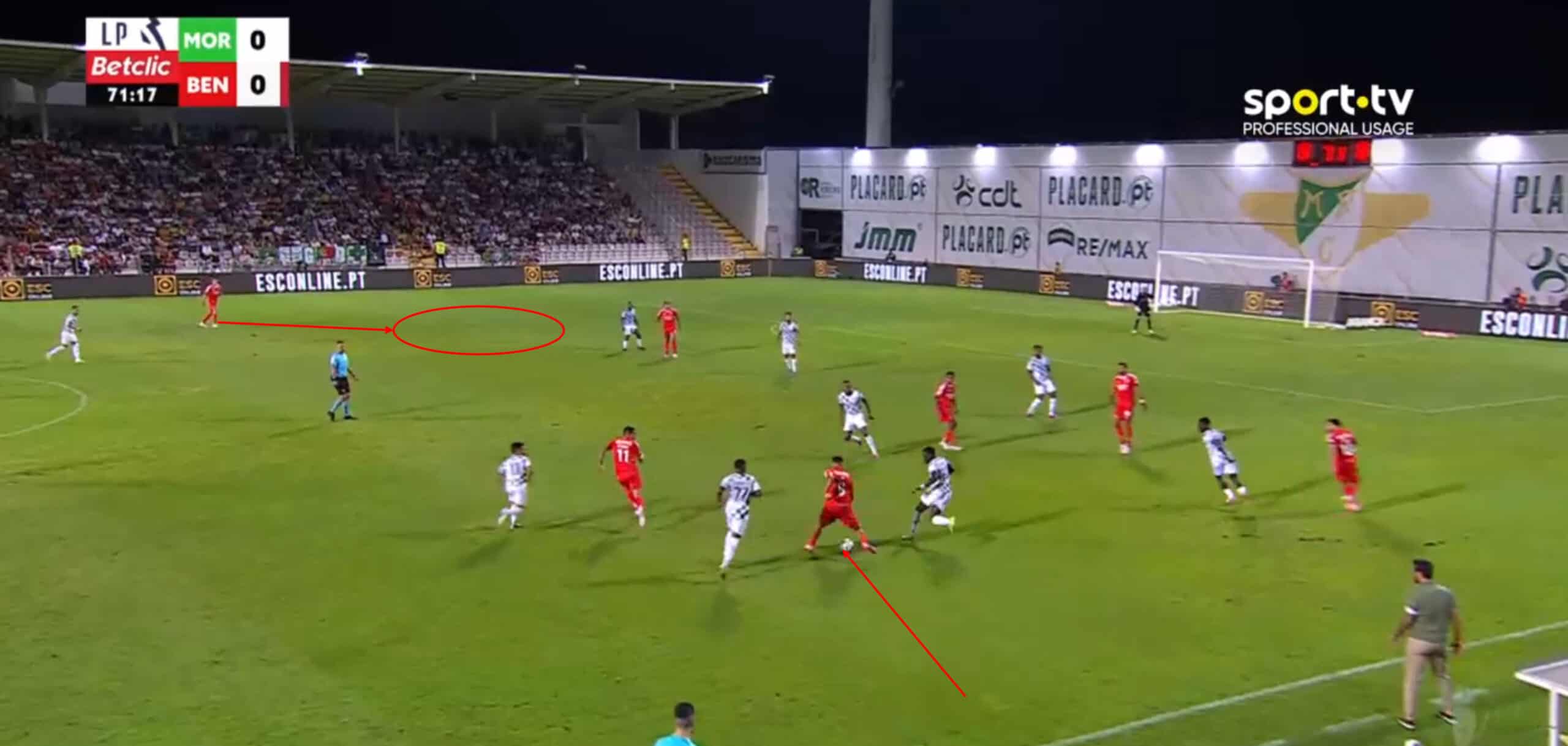
But in the end, it doesn’t even matter at all, because Bah makes a horrible decision as well, dribbling inwards with the ball on his feet, right into three defenders.
From there on, he has pretty much no options to play the ball forward anymore and wasted a great opportunity for his team.
On the left side, Carreras completely sleeps and does not even offer the option to switch play for Bah, which forces the right-back into a take-on attempt against double coverage and he loses the ball.
Looking at situations like these, the Benfica players simply do not react quick enough or have a clear idea of what they are supposed to do with and without the ball.
Roger Schmidt failed to give his players help with orientation and watching those four Benfica games this season, there never was a clear plan to create scoring opportunities, which is unbearable for a team that wants to win the championship.
Conclusion
Considering the huge player turnover before and during the season for Benfica so far, it might seem odd that the club has decided to let go of one of its better managers in the last few years in Roger Schmidt.
If we are looking at the games, it becomes obvious that the team in its current form is not able to compete for the league title, which a Benfica manager always needs to do; with Sporting and Rúben Amorim looking as sharp as ever, Benfica were kind of forced into a coaching change this early in the season.
Roger Schmidt’s Benfica were able to overcome a lot of their struggles with their individual class last season, but after losing João Neves and replacing him with Leandro Barreiro, the team looks lost in possession and can’t rely on their pure talent to overcome this issues anymore.
Is Bruno Lage the solution?
Honestly, I don‘t think so.
Lage was let go after 1.5 years of rather boring football in Lisboa by Benfica and has had two very uninspiring stints for Wolverhampton and Botafogo in the years between his Benfica gigs.
If Lage wants to have success, he quickly needs to give his players easy solutions to control the centre of the pitch and in the passing game to overcome the struggles in possession, but making those changes while playing games every three days will be extremely tough.
Last but not least, Lage will need to make use of his newly added players, like Kerem Atürkoglu, rather quickly, to bolster the individual class in attack quickly.
Overall, I highly doubt that Benfica will be a match for Rúben Amorim’s Sporting team this season, but the quality is there in theory.
It will be interesting to see how Benfica’s season under Lage will develop in the upcoming weeks.






Comments